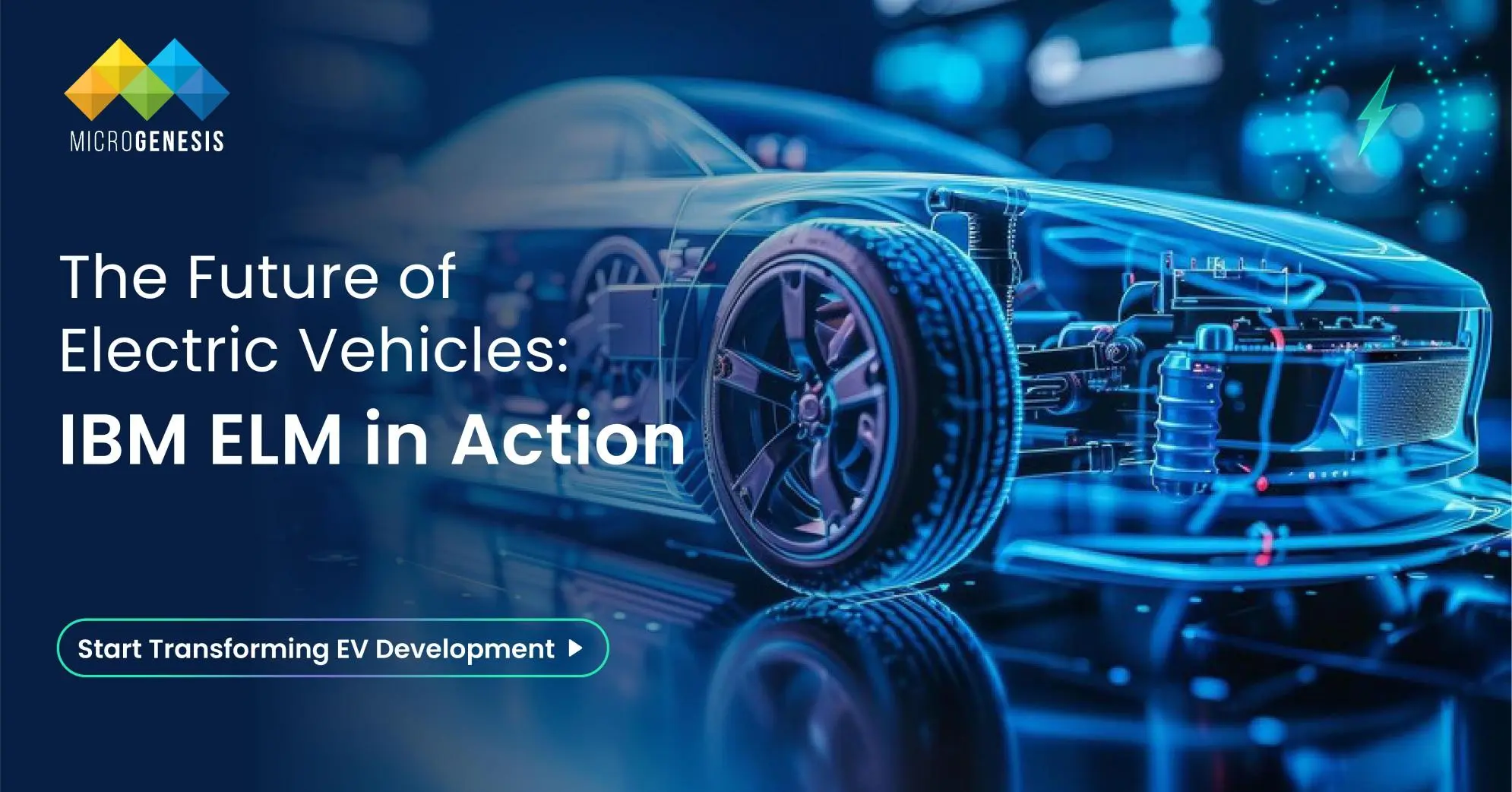The electric vehicle (EV) market is growing rapidly, driven by increasing consumer demand for eco-friendly transportation and stricter government regulations on emissions. However, designing and developing EV systems is inherently complex, requiring the seamless integration of hardware, software, and mechanical components. Traditional methods of managing these complexities are no longer sufficient.
This is where IBM Engineering Lifecycle Management (ELM) comes into play. IBM ELM provides a comprehensive suite of tools that help automotive manufacturers and suppliers address the challenges of EV system design and development. In this blog, we’ll explore how IBM ELM can simplify and streamline the EV development process by improving collaboration, traceability, and system integration.
Understanding the Complexity of EV Systems
Electric vehicles are more than just cars with electric motors. They are sophisticated systems that involve various interconnected subsystems, including:
- Battery Management Systems (BMS)
- Electric Powertrains
- Advanced Driver Assistance Systems (ADAS)
- Vehicle Control Units (VCUs)
- Infotainment Systems
Each of these subsystems requires careful coordination to ensure optimal performance, safety, and reliability. Managing the design, development, and testing of these systems poses several challenges:
- Multi-disciplinary Teams: EV development involves collaboration between electrical engineers, software developers, mechanical engineers, and more.
- Regulatory Compliance: EV systems must meet strict safety and environmental regulations.
- Traceability and Accountability: Every requirement, design decision, and test must be traceable to ensure compliance and quality.
How IBM ELM Addresses EV Development Challenges
IBM ELM is a comprehensive solution that integrates tools for requirements management, systems design, testing, and change management. Here’s how it addresses key challenges in EV system design and development with the expertise of an IBM ELM Consultant.
1. Requirements Management with IBM DOORS Next
Managing requirements is a critical part of the EV development process. IBM DOORS Next provides a centralized platform for capturing, managing, and tracing requirements throughout the project lifecycle.
- Capture and Organize Requirements: Easily capture and organize requirements from various stakeholders.
- Traceability: Establish traceability links between requirements, design elements, and test cases to ensure nothing is missed.
- Change Management: Track changes to requirements and understand their impact on the project.
Use Case Example: A battery management system (BMS) requires precise temperature regulation to ensure safety and efficiency. With IBM DOORS Next, you can capture temperature regulation requirements and trace them through the design and testing phases to ensure compliance.
2. System Design with IBM Rhapsody
IBM Rhapsody is a model-based systems engineering (MBSE) tool that helps teams design complex systems visually.
- Model-Based Approach: Create visual models of EV subsystems to better understand their interactions.
- Simulation and Validation: Simulate system behavior to identify potential issues early in the development process.
- Collaboration: Enable cross-disciplinary collaboration by providing a shared understanding of system designs.
Use Case Example: Designing an electric powertrain requires coordination between mechanical, electrical, and software teams. Using IBM Rhapsody, teams can create a unified model of the powertrain system, simulate its behavior, and identify potential integration issues before physical testing.
3. Test Management with IBM Engineering Test Management (ETM)
Testing is a critical part of EV development, ensuring that all systems work as intended and meet regulatory standards. IBM ETM helps manage test plans, test cases, and test execution.
- Comprehensive Test Plans: Create detailed test plans that cover all aspects of EV systems.
- Automated Testing: Integrate with automated testing tools to streamline the testing process.
- Defect Tracking: Track defects and ensure they are resolved before the vehicle goes into production.
Use Case Example: An advanced driver assistance system (ADAS) requires extensive testing to ensure safety. IBM ETM allows teams to manage and execute test cases, track defects, and ensure that the system meets safety standards.
4. Change and Configuration Management with IBM Engineering Workflow Management (EWM)
Managing changes in a complex project like EV development is challenging. IBM EWM provides tools for managing changes, tracking progress, and ensuring accountability.
- Change Requests: Manage change requests and track their impact on the project.
- Version Control: Maintain version control of all project artifacts to ensure consistency.
- Collaboration: Facilitate collaboration between team members, even if they are in different locations.
Use Case Example: During the development of an infotainment system, a change request is made to add a new feature. IBM EWM helps track the change request, assess its impact, and ensure that all related artifacts are updated accordingly.
Read More : Comprehensive Guide to Rhapsody Model Manager: Revolutionizing Architectural Management
What Happens When We Don’t Use Tools Like IBM ELM in EV Development?
Without tools like IBM ELM, the development of electric vehicles can quickly become chaotic and inefficient. Here are some key risks and challenges that arise when proper lifecycle management tools are not used:
1. Lack of Traceability
Without a centralized system to manage requirements, designs, and test cases, it becomes challenging to trace how requirements are being met throughout the development process. This can lead to:
- Missed requirements
- Incomplete testing
- Increased risk of defects
2. Poor Collaboration
EV development involves multiple teams across different disciplines. Without a collaborative platform, communication gaps can occur, leading to:
- Misaligned goals
- Duplicate efforts
- Delays in project timelines
3. Inefficient Change Management
Change is inevitable in any complex project. Without a tool to track changes and their impacts, teams risk:
- Introducing defects
- Overlooking critical updates
- Failing to meet regulatory standards
4. Regulatory Non-Compliance
Meeting safety and regulatory standards is essential in the automotive industry. Without tools to manage compliance, companies risk:
- Fines and legal penalties
- Product recalls
- Damage to brand reputation
5. Delayed Time-to-Market
Inefficient processes lead to longer development cycles, which can delay the launch of new EV models. This impacts a company’s competitiveness in a fast-moving market.
6. Higher Development Costs
Poor project management and lack of automation can increase development costs due to:
- Rework and defect fixes
- Wasted resources
- Inefficient use of personnel
Ensuring Compliance and Safety with IBM ELM
One of the biggest challenges in EV development is ensuring compliance with safety and environmental regulations. IBM ELM helps teams meet these requirements by providing:
- Traceability Reports: Generate reports that show how requirements are traced through design and testing.
- Audit Trails: Maintain a detailed audit trail of all project activities to demonstrate compliance.
- Risk Management: Identify and mitigate risks throughout the project lifecycle.
Regulatory Standards Supported:
- ISO 26262 (Functional Safety)
- ASPICE (Automotive SPICE)
Benefits of Using IBM ELM for EV Development
By adopting IBM ELM, automotive manufacturers and suppliers can:
- Reduce Development Time: Streamline workflows and improve collaboration to bring EVs to market faster.
- Improve Quality: Ensure that all requirements are met and that all systems work as intended.
- Enhance Traceability: Maintain a clear traceability chain from requirements to testing.
- Ensure Compliance: Meet regulatory standards and maintain detailed audit trails.
Conclusion
The complexity of EV system design and development requires modern tools and methodologies. IBM Engineering Lifecycle Management (ELM) provides a comprehensive solution for managing the entire development lifecycle, from requirements capture to testing and change management.
At MicroGenesis, a leading digital transformation company, we specialize in IBM ELM Solutions to help both technical and non-technical teams tackle the complexities of EV development. Our expertise ensures improved collaboration, compliance, and efficiency, empowering organizations to deliver high-quality electric vehicles faster.
Partner with MicroGenesis and embrace IBM ELM to stay ahead in the rapidly evolving automotive industry.n the rapidly evolving automotive industry.




